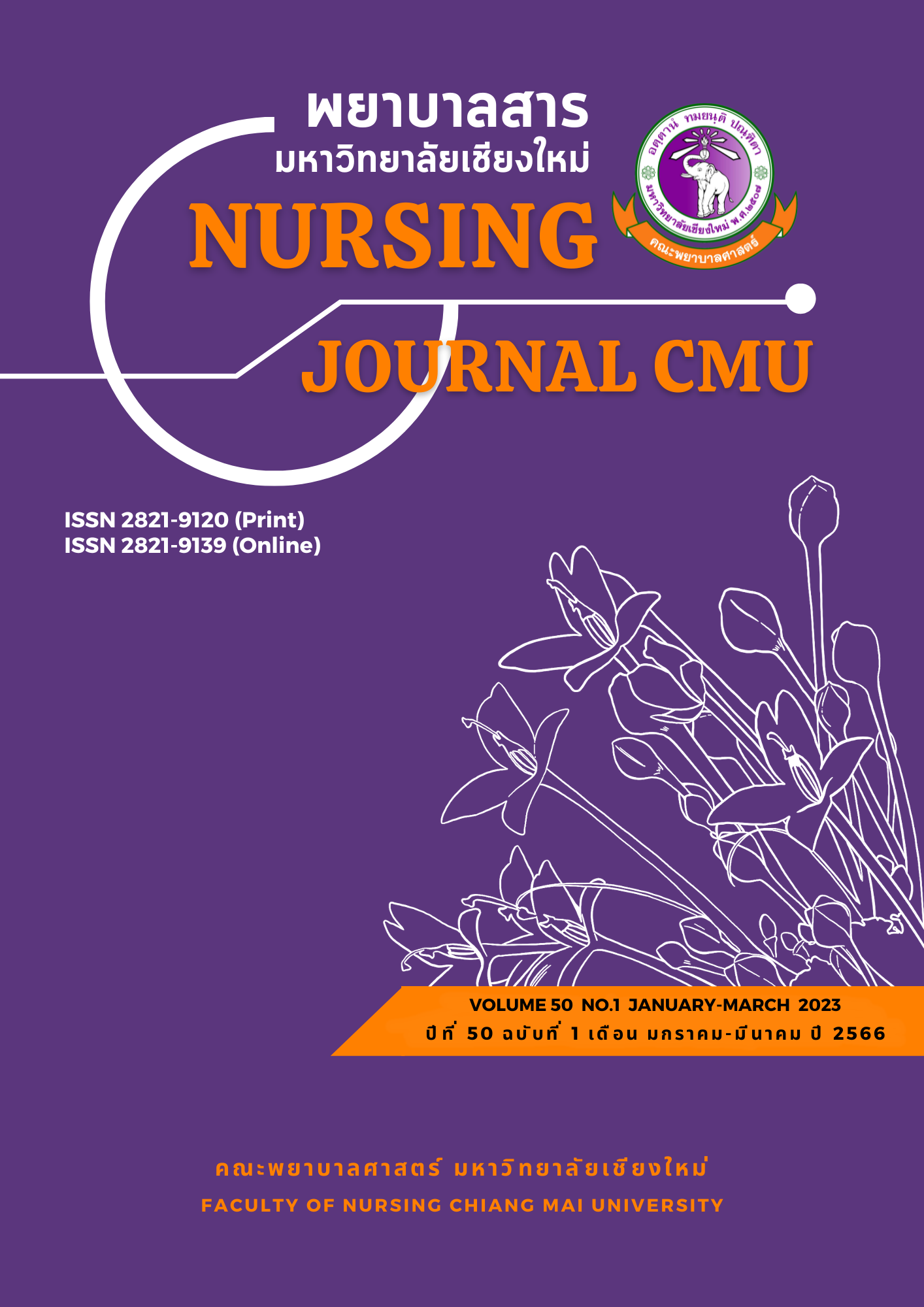The Effect of the Health Belief Enhancing Program on Stroke Prevention Behaviors of At-Risk Persons in a Community
Keywords:
Health belief enhancing program, stroke prevention behaviors, persons at risk for strokeAbstract
The best prevention for stroke is the promotion of health behavior changes for controlling the risk factors that cause the disease. This study examined the effect of the health belief-enhancing program on stroke prevention behaviors of at-risk persons in a community using a two-group quasi-experimental study with a pretest-posttest design. The sample group included 44 persons at risk for stroke, aged 35 years and over, who were equally divided into an experimental group and a control group with 22 persons in each. The study was conducted in Ban Kho Subdistrict, Muang Pan District, Lampang Province. The research instruments included the 12-week health belief enhancing program, which included 5 steps: 1) promoting perceived risk of stroke, 2) promoting perceived severity of stroke, 3) promoting perceived benefits of stroke preventive behaviors, 4) promoting perceived barriers of stroke preventive behaviors, and 5) stroke preventive behaviors motivation. Data were collected using a demographic data questionnaire and a stroke-risk control behavior questionnaire with a reliability coefficient value of 0.81. The data were analyzed using descriptive statistics, Fisher’s exact test, independent t-test, and paired t-test. The results showed that after participating in the health belief enhancing program for 12 weeks, the experimental group had average scores for stroke prevention behaviors which were higher than before participating in the program and more than those of the control group participants who received usual hospital services, with statistical significance (p < .001).
The outcome indicates that the health belief-enhancing programs could improve stroke prevention behavior of at-risk people.
References
Becker, M. H., & Maiman, L. A. (1975). The health belief model: Origins and correlation in psychological theory. Health Education Monography. 2, 336-385.
Chiangtong, K. (2011). Relationships between the health belief model, warning signs perception and management of stroke behavior in the risk group of stroke, Doi Saket District, Chiang Mai Province. (Unpublished master’s thesis). Chiang Mai University, Thailand. (in Thai)
Hirungerd, S., Vutiso, P., & Srimongkol, M. (2021). The effects of health belief model program on knowledge, stroke prevention behavior and blood pressure levels in hypertensive patients the responsibility area of Kaeng Khro Hospital, Chaiyaphum Province.
Journal of The Royal Thai Army Nurses, 22(1), 478-487. (in Thai)
Klinsakorn, C., & Saetan, S. (2020). Factors related to self-protective behavior of stroke with controlled hypertension patients who live in Danchang District. Journal of Council of Community Public Health, 2(2), 62-77. (in Thai)
Kongvivat, K., Lemsawasdikul, W., & Nuysri, M. (2017). Effects of preventive behavior developing program for patients with cerebrovascular disease risk at Kanchanaburi Province. Journal of Nursing and Health Care, 35(3), 129-137. (in Thai)
Kumpiriyapong, N., & Sasat, S. (2017). The effect of health belief program on medicine used behavior in older persons with hypertension. Royal Thai Navy Medical Journal, 44(3), 67-83. (in Thai)
Loussug, W., Lawang, W., & Homsin, P. (2019). The Effects of Application of the Health Belief Model with Family Support Program on Preventive Behaviors Against Cerebrovascular Disease among Individual at Risk. Journal of Nursing and Education, 12(4), 32-45.
Ngerndee, K. (2021). The effectiveness of health belief application program for stroke prevention behavior among hypertensive patients at Muang District, Phayao Province. Phayao: University of Phayao. (in Thai)
Saeko, U., & Jitpanya, C. (2014). A study of stroke awareness among patients at risk of stroke in Bangkok Metropolitan. Princess of Naradhiwas University Journal, 6(2), 19-23. (in Thai)
Sanprakhon, P., Chusri, O., & Wongwisadkul, S. (2018). The effects of health belief application program in older adults with risk of coronary artery disease in a community. Nursing Journal of the Ministry of Public Health, 28(3), 87-100. (in Thai)
Sompol, C., Rawiworakul, T., & Kirdmongkol, P. (2017). Effects of a stroke prevention program for older adults with hypertension. Journal of Public Health Nursing, 31, 57-73. (in Thai)
Strategy and Planning Division. (2019). Public Health Statistics (2019). Retrieved from http://thaincd.com/2016/mission/documents-detail.php=13684&tid=32&gid=1-020(in Thai)
Terathongkum, S., Prasatkaew, N., & Maneesriwongul, W. (2014). Effects of a home visit and telephone follow-up program on health behaviors and health status in persons with uncontrolled hypertension. Ramathibodi Nursing Journal, 20(3), 356-371. (in Thai)
Tiparat, W., Suwanweala, S., & Sumrit, W. (2017). The effects of self-awareness development program on stroke prevention behaviors among hypertension patients in Muang District, Trang Province. The Southern College Network Journal of Nursing and Public Health, 4(2), 94-107. (in Thai)
Veldeman, M., Höllig, A., Clusmann, H., Stevanovic, A., Rossaint, R., & Coburn, M. (2016). Delayed cerebral ischaemia prevention and treatment after aneurysmal subarachnoid haemorrhage: A systematic review. British Journal of Anaesthesia, 117(1), 17-40.
World Stroke Organization. (2018). About world stroke day. Retrieved from https://www.world- stroke.org/world-stroke-day-campaign/world-stroke-day/previous-world-stroke-days/world-stroke-day-2018
Downloads
Published
How to Cite
Issue
Section
License
Copyright (c) 2023 Nursing Journal

This work is licensed under a Creative Commons Attribution-NonCommercial-NoDerivatives 4.0 International License.
บทความที่ได้รับการตีพิมพ์เป็นลิขสิทธิ์ของวารสารพยาบาลสาร
ข้อความที่ปรากฏในบทความแต่ละเรื่องในวารสารวิชาการเล่มนี้เป็นความคิดเห็นส่วนตัวของผู้เขียนแต่ละท่านไม่เกี่ยวข้องกับมหาวิทยาลัยเชียงใหม่ และคณาจารย์ท่านอื่นๆในมหาวิทยาลัยฯ แต่อย่างใด ความรับผิดชอบองค์ประกอบทั้งหมดของบทความแต่ละเรื่องเป็นของผู้เขียนแต่ละท่าน หากมีความผิดพลาดใด ๆ ผู้เขียนแต่ละท่านจะรับผิดชอบบทความของตนเองแต่ผู้เดียว






